Files in this item
Linguistic evidence for Mycenaean epic
Item metadata
| dc.contributor.author | Macleod, Eilidh | |
| dc.coverage.spatial | xiv, 409 p. | en_US |
| dc.date.accessioned | 2018-06-22T15:54:15Z | |
| dc.date.available | 2018-06-22T15:54:15Z | |
| dc.date.issued | 2003 | |
| dc.identifier.uri | https://hdl.handle.net/10023/14497 | |
| dc.description.abstract | It is now widely acknowledged that the Greek epic tradition, best known from Homer, dates back into the Mycenaean Age, and that certain aspects of epic language point to an origin for this type of verse before the date of the extant Linear B tablets. This thesis argues that not only is this so, but that indeed before the end of the Mycenaean Age epic verse was composed in a distinctive literary language characterized by the presence of alternative forms used for metrical convenience. Such alternatives included dialectal variants and forms which were retained in epic once obsolete in everyday speech. Thus epic language in the 2nd millennium already possessed some of the most distinctive characteristics manifest in its Homeric incarnation, namely the presence of doublets and the retention of archaisms. It is argued here that the most probable source for accretions to epic language was at all times the spoken language familiar to the poets of the tradition. There is reason to believe that certain archaic forms, attested only in epic and its imitators, were obsolete in spoken Greek before 1200 B.C.; by examining formulae containing such forms it is possible to determine the likely subject-matter of 2nd millennium epic. Such a linguistic analysis leads to the conclusion that much of the thematic content of Homeric epic corresponds to that of 2nd millennium epic. Non-Homeric early dactylic verse (e.g. the Hesiodic corpus) provides examples of both non-Homeric dialect forms and of archaisms unknown from Homer. This fact, it is argued, points to the conclusion that the 2nd millennium linguistic heritage of epic is evident also from these poems, and that they are not simply imitations of Homer, but independent representatives of the same poetic tradition whose roots lie in the 2nd millennium epic. | en_US |
| dc.language.iso | en | en_US |
| dc.subject.lcc | PA3108.M6 | |
| dc.subject.lcsh | Epic poetry, Greek--Criticism, Textual | en |
| dc.subject.lcsh | Greek language--History | en |
| dc.subject.lcsh | Epic poetry, Greek--Mycenaean influences | en |
| dc.subject.lcsh | Epic poetry, Greek--History and criticism | en |
| dc.title | Linguistic evidence for Mycenaean epic | en_US |
| dc.type | Thesis | en_US |
| dc.type.qualificationlevel | Doctoral | en_US |
| dc.type.qualificationname | PhD Doctor of Philosophy | en_US |
| dc.publisher.institution | The University of St Andrews | en_US |
This item appears in the following Collection(s)
Items in the St Andrews Research Repository are protected by copyright, with all rights reserved, unless otherwise indicated.

